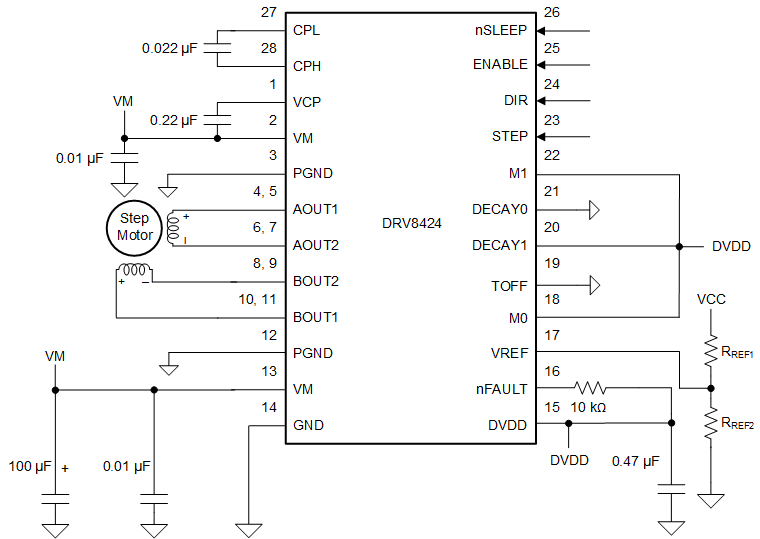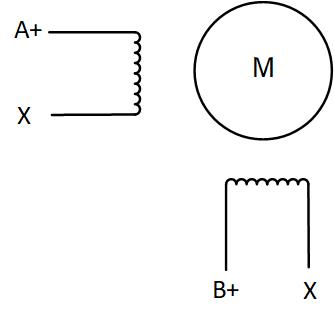SLOA312 December 2021 DRV8412 , DRV8424 , DRV8426 , DRV8428 , DRV8434 , DRV8436 , DRV8803 , DRV8804 , DRV8805 , DRV8806 , DRV8844 , DRV8847 , DRV8932 , DRV8935 , DRV8955
PRODUCTION DATA
3.2 Driving a Unipolar Motor with a Bipolar Driver
This approach has been described in detail in this blog post. One can effectively convert a unipolar stepper motor into a bipolar stepper motor and use a conventional bipolar stepper motor driver such as the DRV8424, DRV8426, DRV8428 and DRV8434 to drive it. This can be done in two ways.
- Ignore the center tap on each winding – The motor effectively looks as shown in Figure 2-2. This configuration energizes the full winding, thus achieving higher torque at lower speeds compared to the corresponding unipolar stepper motor. However the resulting higher inductance causes the torque to drop at a faster rate than that of a unipolar stepper motor - thereby limiting the maximum speed of operation. A typical application schematic with the DRV8424 is shown in Figure 3-3.
 Figure 3-3 Unipolar Stepper Schematic
with DRV8424
Figure 3-3 Unipolar Stepper Schematic
with DRV8424- Use half of each winding – If the center taps of an unipolar stepper are electrically isolated, as shown in Figure 2-1, one can use one of the half windings per phase, as shown in Figure 3-4.
 Figure 3-4 Unipolar Motor with Half
Windings per Phase
Figure 3-4 Unipolar Motor with Half
Windings per PhaseThere are few pros and cons for both of these methods.
- Compared to using the full winding, the half-winding configuration reduces the coil inductance. Therefore using only half winding results in lower torque at lower speed, but at the same time results in higher available torque at high speeds.
- For the torque for both configurations to be the same, half winding approach needs to drive with 2x the current compared to full winding driving. This however results in worse thermal performance - (I2*R for full winding compared to ((2I)2*R/2 = 2I2R) for half winding driving.
- Additionally, using only half of a winding results in noisier voltage and current waveforms.
Both half windings cannot be paralleled because the mutual inductance will cancel out the respective phase.
Table 3-2 summarizes the major features of these four bipolar stepper drivers.
| Driver | DRV8424 | DRV8426 | DRV8428 | DRV8434 |
|---|---|---|---|---|
| Maximum Supply Voltage | 33 V | 33 V | 33 V | 48 V |
|
MOSFET RDS(ON) (HS +LS) |
0.33 Ω | 0.9 Ω | 1.5 Ω | 0.33 Ω |
| Input Interface | STEP/DIR with up to1/256 microstepping | STEP/DIR with up to1/256 microstepping | STEP/DIR with up to1/256 microstepping | STEP/DIR with up to 1/256microstepping, DRV8434S with SPI interface |
| Package Options | HTSSOP-28, QFN-24 | HTSSOP-28,QFN-24 | HTSSOP-16,QFN-16 | HTSSOP-28,QFN-24 |
| Maximum Continuous Output Current | 2.5 A | 1.5 A | 1 A | 2.5 A |
| Protection Features | Overcurrent, Short circuit, Undervoltage, Overtemperature | Overcurrent, Short circuit, Undervoltage, Overtemperature | Overcurrent, Short circuit, Undervoltage, Overtemperature |
Overcurrent, Short circuit, Undervoltage, Overtemperature, Open load detection, DRV8434A/S with stall detection |